The 2011 Mid-Range SSD Roundup: 120GB Agility 3, Intel 510 and More Compared
by Anand Lal Shimpi on June 7, 2011 12:52 PM ESTOverall System Performance using PCMark Vantage
Next up is PCMark Vantage, another system-wide performance suite. For those of you who aren’t familiar with PCMark Vantage, it ends up being the most real-world-like hard drive test I can come up with. It runs things like application launches, file searches, web browsing, contacts searching, video playback, photo editing and other completely mundane but real-world tasks. I’ve described the benchmark in great detail before but if you’d like to read up on what it does in particular, take a look at Futuremark’s whitepaper on the benchmark; it’s not perfect, but it’s good enough to be a member of a comprehensive storage benchmark suite. Any performance impacts here would most likely be reflected in the real world.
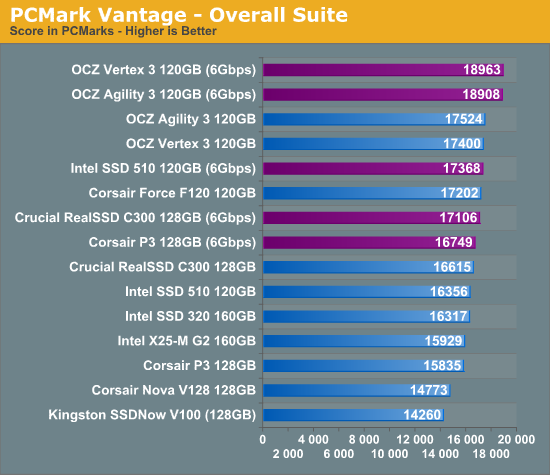
The SandForce drives hold a 10% advantage over the Intel SSD 510 in this test. For truly light desktop workloads it's near impossible to offer better performance than SandForce as most of the data written never actually hits NAND.
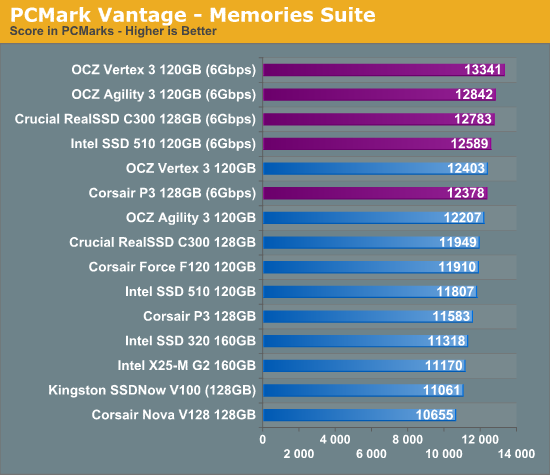
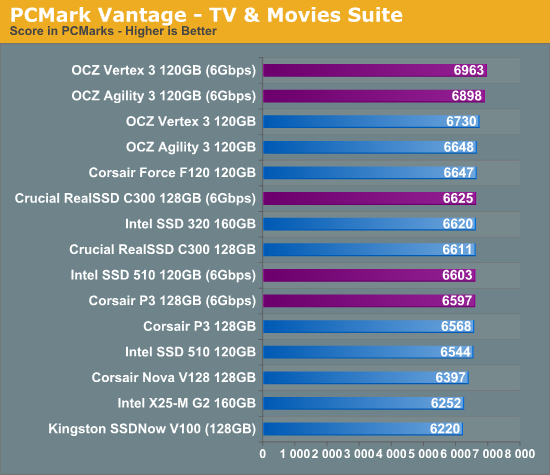

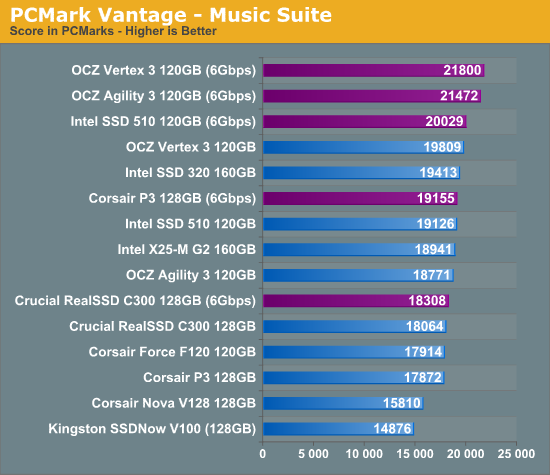
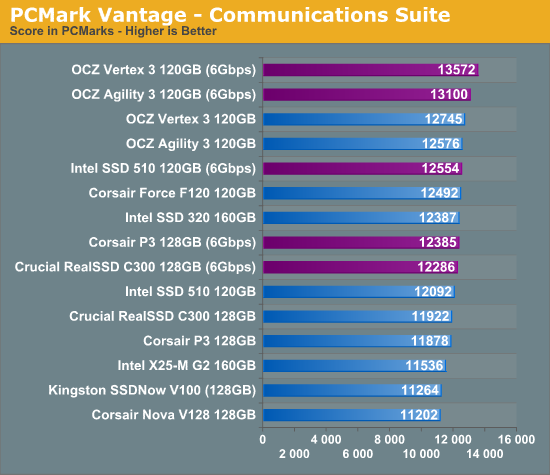
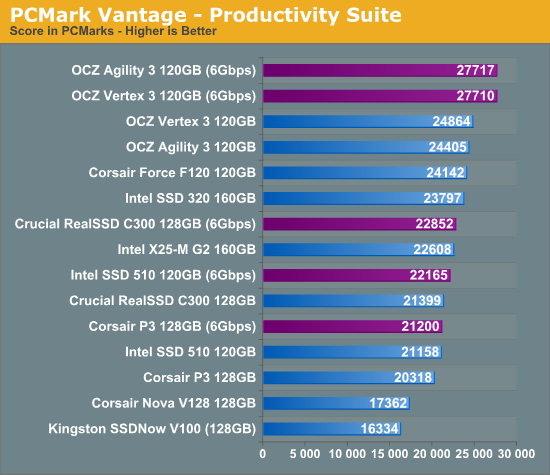
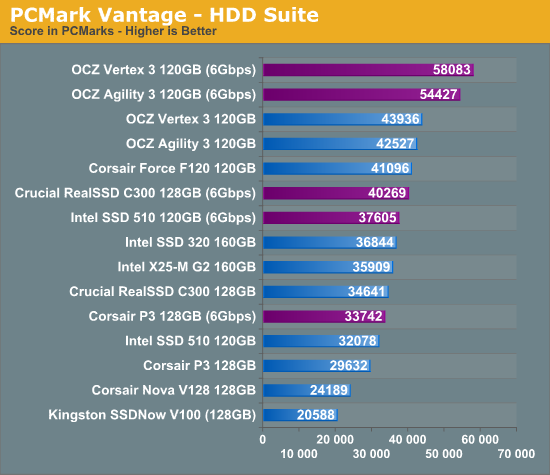










68 Comments
View All Comments
voidi - Wednesday, June 8, 2011 - link
I've been waiting for an article like this for a long time. I think there are more people interested in the middle-class, 120GB SSDs, because everything above that capacity is still very expensive, and 120GBs should prove sufficient for most users to store the OS + a load of programs + all games you currently play from time to time. Twice the space is always nice, of course, but I don't feel it's necessary.Thank you so much for this review!
voidi - Wednesday, June 8, 2011 - link
By the way, in Europe, the Agility 3 120GB is currently ~180 € with shipping, whereas the Vertex 3 120GB goes for ~215 €. Interesting to see that the pricing is so different in the US, even in favor of the Vertex sometimes.voidi - Wednesday, June 8, 2011 - link
I just realized you corrected that already, nevermind :)wvh - Wednesday, June 8, 2011 - link
Thanks for the article. It seems there really isn't a bad choice amongst those options, depending on one's priorities.Anand, could you do a short section on encryption in the next article? There are lots of manufacturers who claim their products support encryption, but there's a lot of conflicting information out there and it would be good to know which drives – if any – offer reliable encryption from a data security point of view, and how they provide this security (ATA boot? TPM?).
jensend - Wednesday, June 8, 2011 - link
I was among those clamoring for this a while back, and would like to thank you for doing this review. Hopefully comparative reviews of lower-than-highest-capacity SSDs will become commonplace throughout the tech world moving forward.anotherengineer - Wednesday, June 8, 2011 - link
Great review Anand. However on the first page with the SSD comparison table, how come you didn't include the firmware version that was used for the testing?Thanks
sean.crees - Thursday, June 9, 2011 - link
First, i didn't see the F120 in the price graph in the beginning, but noticed it in the benchmarks.On a 3gb controller, its performance is very competative, and the power consumption is among the best available.
Then i went to newegg to check the price. $215 for the 120g is a lot less than anything else in this round-up. Thats only $179 per GB. So it is simultaniously the best total price, and best price per GB. With the top 3 best performance on a 3gb controller, and the best power consumption.
How is the F120 not highly recommended in this review?
The one thing that i think Anand forgets is that 3gb controllers are still more common, especially if your using an SSD to upgrade an existing laptop/desktop computer.
JasonInofuentes - Thursday, June 9, 2011 - link
Not sure if this is specifically why Anand didn't include it, but part of the trouble with reviewing tech hardware is that it's always unclear just how long a piece of technology will stay not just relevant but available. Is the Corsair a competitive drive in the SATA II space? You bet, I actually was thinking of putting one to use in my system. Is it pretty available on sites like NewEgg? Yeah, but for how long. It's an older drive at this point and the amount of time it stays on the market is unknown. Better to tell you, and the guy that checks this article out in August after he's earned some cash over the summer for a new build, what is the best drive that WILL be available in a few months, and likely for a while after that.What I think everyone is really itching for is the $/GB to fall steeply thanks to the move to 25 nm NAND. The era of $1/GB SSDs are probably still some ways off, but I would hope that we could enjoy a drift towards $1.5/GB before 19 nm NAND hits the streets.
Jason
superccs - Thursday, June 9, 2011 - link
Every time I come here I see you look at performance on multiple platforms, which makes sense , but lately it seems that it is Intel board X and Intel board Y. How hard is it to find a 890 board and throw some new toy in it?There are quite a few peeps out there who use AMD hardware so throw us a bone damnit.
.
Mitch101 - Thursday, June 9, 2011 - link
What we need now is a reliability report. I know of several people (3) with SSD drives and all have experienced a drive failure and these are desktops not servers, no defrag, with virtual swap files. Speed is great but if I have to replace the drive every 6-9 months because of failure Im staying away.